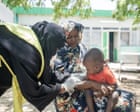
In a rapidly evolving world, various challenges and incidents are unfolding across different regions, painting a complex tableau of human endeavor and tribulations. This comprehensive overview offers insights into several major occurrences, each bearing its unique impact and significance.
In Sudan, the innocence of childhood faces a dire threat amid declining vaccination rates. Once robust, the immunization drive has waned drastically due to ongoing conflicts, leaving only 48% of the nation’s children vaccinated—significantly reduced from the 90% coverage achieved in previous years. The World Health Organization highlights this as part of what they describe as the world’s largest humanitarian crisis. Sudanese children now stand dangerously exposed to preventable infectious diseases, a situation exacerbated by the chaotic sociopolitical landscape.
Meanwhile, a small community in Canada is grappling with shock and sorrow following the alleged assault of an eight-year-old girl by a seventeen-year-old boy. Initially believed to be an animal attack, the incident in Quadeville led authorities to issue warnings for children to remain indoors. As law enforcement continues their investigation, the town’s residents are left to wrestle with misplaced trust and an unsettling sense of vulnerability.
In the field of cybersecurity, a report forewarns of rising risks of attacks on undersea cables, the critical arteries of global internet traffic. A spate of incidents in the Baltic Sea and around Taiwan, reportedly backed by Russia and China, underscores this growing concern. Submarine cables, carrying 99% of the world’s intercontinental data, are the latest targets in a complex geopolitical landscape, portending a future of heightened vigilance and defense.
Tragedy also struck in Iraq, where a fire claimed over 60 lives in a newly opened shopping mall in Kut. The blaze was reportedly triggered by an air conditioning unit malfunction, leading to multiple fatalities as panicked patrons sought refuge in restrooms and elevators. This incident surfaces questions about safety protocols and emergency preparedness in newly developed infrastructures.
In the ongoing humanitarian plight in Gaza, a food distribution site became a scene of chaos when a surge resulted in the deaths of over twenty people. Eyewitnesses report that crowd control measures led to panic and a deadly crush, stirring additional distress in an already fraught region. The Gaza Humanitarian Foundation’s use of tear gas or pepper spray remains under scrutiny as part of the inquiry into this heart-wrenching episode.
Another tragedy unfolded in the skies last month, with Air India’s confirmation of no mechanical issues following an investigative turn toward the human factors in a fatal crash that claimed 260 lives. The US report indicated a possible mishandling of fuel switches by the captain, igniting conversations around aviation safety and procedural adherence in flight operations.
Additionally, an accidental data leak involving the names of SAS personnel and MI6 officers poses further security concerns. This sensitive information, accidentally shared concerning Afghan relocation efforts post-Taliban takeover, underscores the challenges of maintaining security and confidentiality during large-scale humanitarian crises.
As these stories unfold, they serve as reminders of the critical balance between progress and precaution, security and privacy, and the ongoing commitment required to address human and environmental challenges with compassion and foresight. Each situation calls for thoughtful engagement and resolution, aiming towards a harmonious and resilient global community.
Source: {link}
